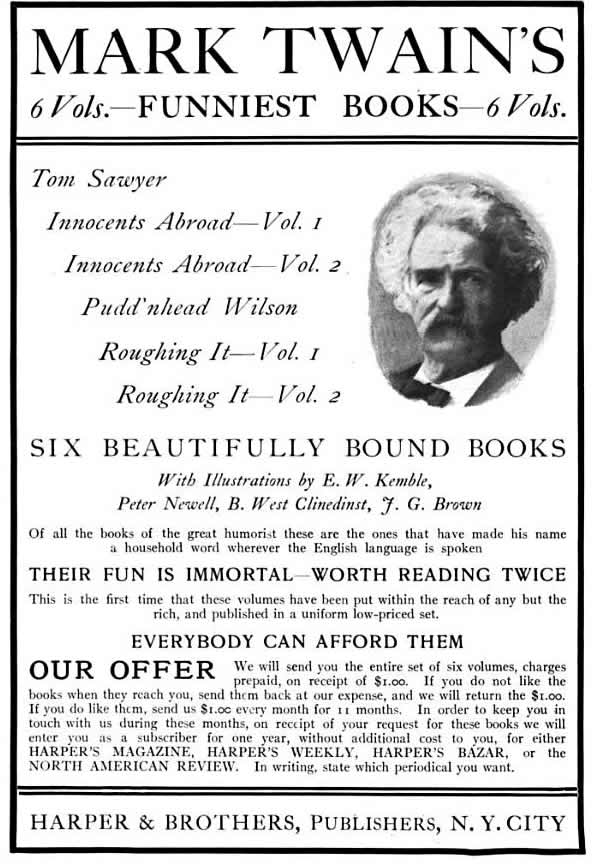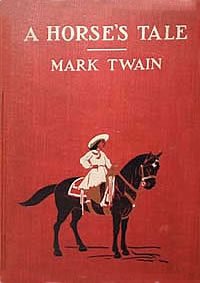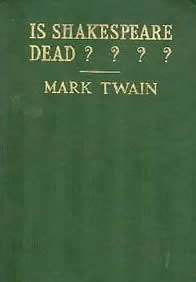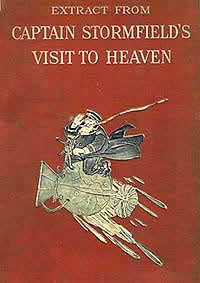
A History of and Guide to
UNIFORM EDITIONS OF MARK TWAIN'S WORKS
"The books paid $40,000 for the year -- which is distinctly better
than either of the two previous years."
- Samuel Clemens to Henry H. Rogers, 1 January 1907
_____
Chapter 7
Mark Twain's Final Years 1904-1910
and a New Decade of Books
More Stories and More Volumes
The ink had barely dried on the contracts of October 1903 before
Harper and Brothers advertised their new acquisitions of six volumes of Mark
Twain's "funniest books." The Clemens family had relocated to Italy
in late 1903 and the new advertising campaign did not escape Clemens's notice.
He wrote to Henry Rogers on 28 November 1903:
Harper is advertising 6 vols of my "funniest books" in McClure's
mag. All right, but I thought the contract did not allow "imcomplete
sets" to be sold. I'm not objecting, but I doubt the wisdom of issuing
selected volumes and suggesting to the public that the others are inferior.
But I would surely have to object [if] they advertised to sell a broken
set by subscription -- which they don't (Leary, p. 543).

This advertisement
appeared in December 1903 in the following publications: Atlantic Monthly,
Critic, Bookman, Dial, Literary World, Current Opinion and Scribners.
It represented the takeover by Harper and Brothers of the American Publishing
Company's rights to some of Mark Twain's most popular works and emphasized
the affordablity with which they were being offered.
A few weeks later on January 5, 1904 he wrote to Frederick Duneka
of Harper and Brothers about his own ideas for expanding the uniform editions.
He planned "to dig out one of my unfinished novels -- a couple of them.
Not for issue as single books, & not serially, but only to be added to
the Complete Subscription set" (Emerson, p. 271). Clemens's apparent
reasoning was that selling more than 20 books at one time was better than
selling only one and that owners of previous sets would feel compelled to
keep buying new volumes in order to keep their sets complete.
Between the time his contract with Harper and Brothers had been
signed in October 1903 and the end of 1905 Clemens published new magazine
material including "A Dog's Tale" in the Christmas 1903 issue of
Harper's Magazine; "Italian Without a Master" in Harper's
Weekly of January 2, 1904; "Italian With Grammar" in Harper's
Monthly of August 1904; Saint Joan of Arc in Harper's Monthly
of December 1904; "The $30,000 Bequest" in Harper's Weekly
of December 10, 1904; "The First Writing Machines," in Harper's
Weekly of March 18, 1905; "The Czar's Soliloquy" in North
American Review in March 1905; "A Humane Word from Satan" in
Harper's Weekly of April 8, 1905; "A Monument to Adam" in
Harper's Weekly of July 15, 1905; "Overspeeding" in Harper's
Weekly of November 4, 1905; "A Helpless Situation" in Harper's
Bazaar for November 1905; and "Eve's Diary" in Harper's Monthly
of December 1905. In September 1906 Harper's compiled enough of the new material
to add another volume to Mark Twain's uniform editions and issued The $30,000
Bequest and Other Stories as a standalone first edition as well as Volume
24 of the uniform editions, although the contents of the the two books would
not be identical. Harper was aiming at two sets of buyers -- those who had
never purchased the previous uniform sets and those buyers who wanted to continue
adding new volumes to their sets.
Harper's publications continued to feature additional Mark Twain
material throughout 1906 including "Carl Shurz, Pilot" in Harper's
Weekly for May 26, 1906; "William Dean Howells" in Harper's
Monthly of July 1906 and "A Horse's Tale" in Harper's Monthly
of August and September 1906. A year later Harper would publish A Horse's
Tale as a standalone book. In December 1906 he published "Hunting
the Deceitful Turkey" in Harper's Monthly. In September 1906 Col
George Harvey's North American Review began serializing "Chapters
from my Autobiography." It was a serialization that would run through
December 1907. Clemens's contract with Harper and Brothers had provided him
with a good income during the intervening years. On New Year's Day 1907 he
wrote Henry Rogers, "The books paid $40,000 for the year -- which is
distinctly better than either of the two previous years. The Autobiography
has paid about $12,000 to $15,000 thus far." (Leary, p. 623).
In February 1907 Harper and Brothers published Christian
Science as another standalone first edition which was also added to the
uniform editions as Volume 25. The book contained some of Mark Twain's older
magazine contributions on the topic of Christian Science as well as new material
he had written that had not been previously published on the topic. The best
discussion of the tangled history of the book's fragmented composition and
previous piecemeal publications is in What is Man? And Other Philosophical
Writings, edited by Paul Baender, University of California Press, 1997.
The December 1907 issue of North American Review published his "The
Story of a Speech." Clemens rounded out the year 1907 by publishing material
from a manuscript he had worked on for decades -- "Extract from Captain
Stormfield's Vist to Heaven" which appeared in the December 1907 and
January 1908 issues of Harper's Monthly. Harper would later release
it as a small standalone book.
The financial statement "Volumes of Mark Twain Sold from
Nov 1-1903 to Oct 31-1907" provided from Harper's to Clemens indicates
the success the company had with their publishing endeavors. On 22 May 1908
Clemens cited the figures in his autobiographical dictation:
Old as the books are, the sales have increased each year instead
of diminishing, as is the custom. The aggregate of volumes sold in the first
year by the Harpers was 90,328; in the second year 104,851; in the third year
133,975; in the fourth year -- which was last year -- the sale was 160,000
volumes. The aggregate for the four years is 500,000 volumes lacking 11,000.
... The royalties paid my by the Harpers in the four years were as follows:
in 1904, $24,939; in 1905, $29,311.92; in 1906, $39,284.33; in 1904, $48,225.98.
Aggregate for the four years, $141,761.23 (Autobiography of Mark Twain,
Volume 3).
In April 1909 Harper published Mark Twain's Is Shakespeare
Dead? as a standalone first edition. That same year Mark Twain's Harper
magazine contributions included "A New Planet" in Harper's Weekly
on January 30; "A Fable" in Harper's Monthly in December
1909 and "Marjorie Fleming, the Wonder Child" in Harper's Bazaar
also in December 1909. To take advantage of the holiday gift giving season
Harper published Extract from Captain Stormfield's Visit to Heaven
as a short book of 15,000 words in December 1909. Clemens likely envisioned
yet another volume that could be added to the uniform edition of his works.
However, none of the new books would ever be added to the uniform edition
sets during Clemens's lifetime.
Three of the books published by Harper in Clemens's lifetime
which were never added to the uniform editions while he was living

A Horse's
Tale
published in October 1907 |

Is Shakespeare
Dead?
published in April 1909 |

Extract
from Captain Stormfield's Visit to Heaven published in October 1909
|
Another Offer from Collier and Harper's Response
On May 9, 1909 Clemens wrote to Henry Rogers that he had again
been in discussions with Robert Collier to issue a cheap edition of his uniform
works. Clemens's five year guarantee of $25,000 annually had expired and he
was anxious to renegoiate another deal with Harper that would reinstate it.
Wednesday I go to Deal Beach to discuss with the Colonel the proposition
to let Collier have a cheap edition ($19) for 5 years. Collier to guarantee
to sell so-many sets in that time. We began the discussion last Thursday.
Collier exhibited telegrams (on a 5-year estimate) from all his general
agents but ten, and the Colonel was visibly impressed. I am offering the
Harpers half of the swag, but I want them to restore my guaranty
of $25,000-per-annum for another 5 years. If we make the Collier-trade they
can't decline, I think (Leary, p. 663).
This would be the last letter that Clemens would write to Rogers. Henry Rogers
died ten days later on May 19, 1909. Up to the date of his death Clemens had
relied on him for business advice including negotiating deals for the uniform
edition of his works. The proposed deal to let Collier issue a cheap uniform
edition in 1909 never materialized in his lifetime. Instead, George Harvey,
evidently impressed by the marketing numbers Collier had shown him, decided
to issue the Author's National
Edition of Mark Twain's works in 1909. The set would be priced low enough
that every American with an average income could afford it.
In February 1910 Clemens published "The Turning Point of My Life"
in Harper's Bazaar. It was the last contribution he made to Harper's
publications before his death two months later. The 25-volume Author's National
Edition was the last set issued in Clemens's lifetime. The set was so successful
it was released throughout the next decade in the following bindings:
_____
References
Baender,
Paul, ed. What is Man? And Other Philosophical Writings. (University
of California Press, 1997.)
Emerson,
Everett. Mark Twain: A Literary Life. (University of Pennsylvania Press,
2000).
Griffin,
Benjamin and Harriet Elinor Smith, eds. Autobiography of Mark Twain, Volume
3. (University of California Press, 2015).
Leary,
Lewis, ed. Mark Twain's Correspondence with Henry Huttleston Rogers 1893-1909.
(University of California Press, 1969).
LeMaster,
J. R. and James D. Wilson. The Mark Twain Encyclopedia. (Garland Publishing,
1993).
Messent,
Peter. The Short Works of Mark Twain. (University of Pennsylvania Press,
2001).
Rasmussen,
R. Kent. Critical
Companion to Mark Twain, Volumes I and II. (Facts on File, 2007).
Shelden,
Michael. Mark Twain: Man in White. (Random House, 2010).





